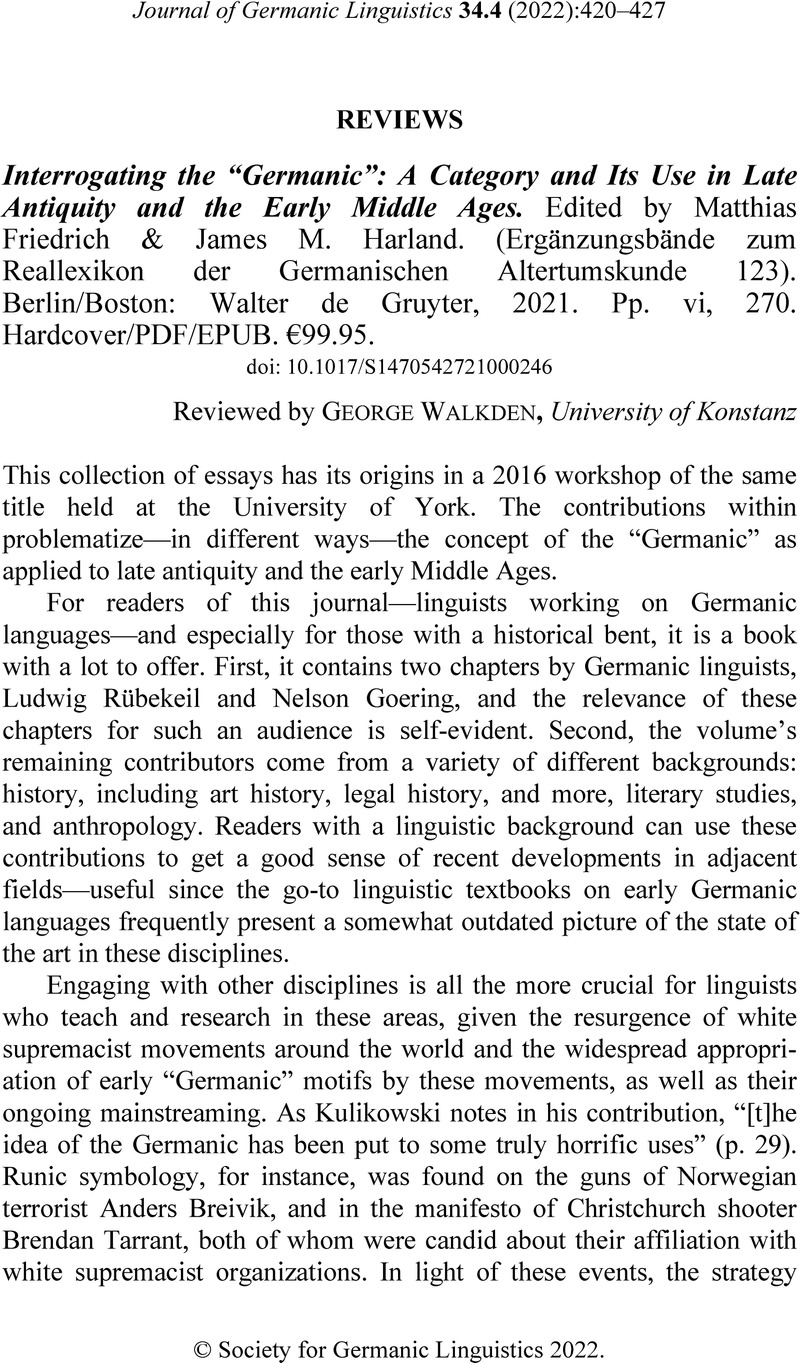No CrossRef data available.
Article contents
Interrogating the “Germanic”: A Category and Its Use in Late Antiquity and the Early Middle Ages. Edited by Matthias Friedrich & James M. Harland. (Ergänzungsbände zum Reallexikon der Germanischen Altertumskunde 123). Berlin/Boston: Walter de Gruyter, 2021. Pp. vi, 270. Hardcover/PDF/EPUB. €99.95.
Review products
Interrogating the “Germanic”: A Category and Its Use in Late Antiquity and the Early Middle Ages. Edited by Matthias Friedrich & James M. Harland. (Ergänzungsbände zum Reallexikon der Germanischen Altertumskunde 123). Berlin/Boston: Walter de Gruyter, 2021. Pp. vi, 270. Hardcover/PDF/EPUB. €99.95.
Published online by Cambridge University Press: 14 November 2022
Abstract
An abstract is not available for this content so a preview has been provided. Please use the Get access link above for information on how to access this content.

- Type
- Reviews
- Information
- Copyright
- © Society for Germanic Linguistics 2022
References
REFERENCES
Balibar, Étienne. 1991. The nation form: History and ideology. Race, nation, class: Ambiguous identities, ed. by Balibar, Étienne & Wallerstein, Immanuel M., 86–106. London: Verso.Google Scholar
Bech, Kristin, & Walkden, George. 2016. English is (still) a West Germanic language. Nordic Journal of Linguistics 39. 65–100.CrossRefGoogle Scholar
Deleuze, Gilles, & Guattari, Félix. 1987. A thousand plateaus: Capitalism and schizophrenia. Trans. Massumi, Brian. Minneapolis, MN: University of Minnesota Press.Google Scholar
Hartmann, Frederik. 2020. The Vandalic language: Origins and relationships. Heidelberg: Carl Winter.Google Scholar
Jarnut, Jörg. 2004. Germanisch: Plädoyer für die Abschaffung eines obsoleten Zentralbegriffes der Frühmittelalterforschung. Die Suche nach den Ursprüngen: Von der Bedeutung des frühen Mittelalters, ed. by Pohl, Walter, 111–113. Vienna: Verlag ÖAW.Google Scholar
Pascual, Rafael J. 2016. Old English metrical history and the composition of Widsið. Neophilologus 100. 289–302.Google Scholar
Rambaran-Olm, Mary. 2018. Anglo-Saxon studies, academia and white supremacy. Unpublished manuscript, University of Toronto. Available at https://mrambaranolm.medium.com/anglo-saxon-studies-academia-and-white-supremacy-17c87b360bf3, accessed in April 2021.Google Scholar
Rambaran-Olm, Mary. 2020. History bites: Resources on the problematic term “Anglo-Saxon”. Unpublished manuscript, University of Toronto. Available at https://mrambaranolm.medium.com/history-bites-resources-on-the-problematic-term-anglo-saxon-part-1-9320b6a09eb7, accessed in April 2021.Google Scholar
Reynolds, Susan C. 1985. What do we mean by “Anglo-Saxon” and “Anglo-Saxons”? Journal of British Studies 24. 395–414.Google Scholar
Rummel, Philipp von. 2007. Habitus barbarus: Kleidung und Repräsentation spätantiker Eliten im 4. und 5. Jahrhundert. Berlin: De Gruyter.CrossRefGoogle Scholar
Vernon, Matthew X. 2018. The Black Middle Ages: Race and the construction of the Middle Ages. London: Palgrave Macmillan.CrossRefGoogle Scholar
Wilton, David. 2020. What do we mean by Anglo-Saxon? Pre-conquest to the present. Journal of English and Germanic Philology 119. 425–454.CrossRefGoogle Scholar



